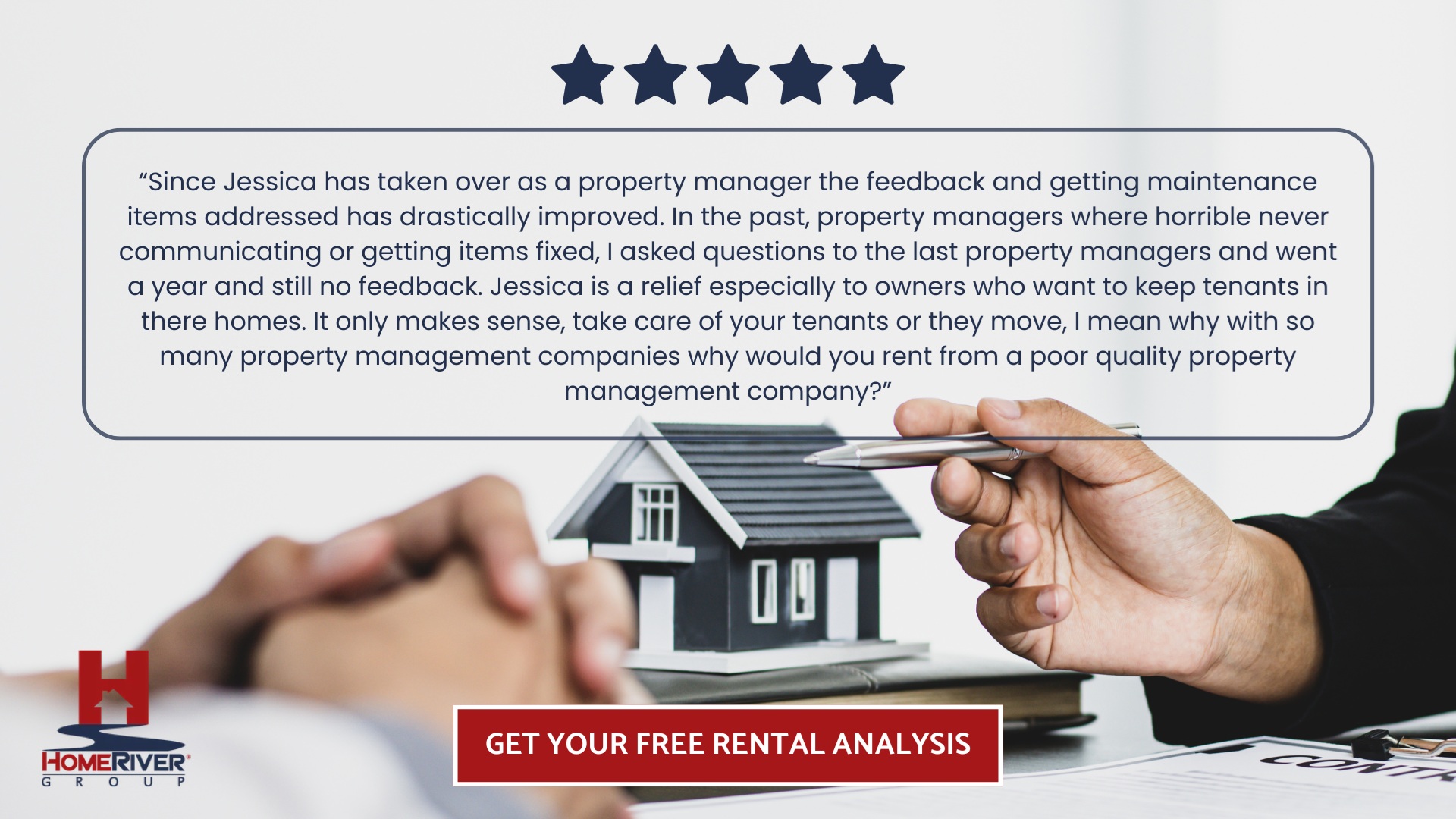
At HomeRiver Group, excellence is our everyday standard. From coast to coast, we deliver end-to-end property management solutions tailored to your investment goals. With cutting-edge technology, local expertise, and a deep understanding of real estate strategy, we simplify leasing, optimize returns, and protect your property at every turn. Whether you're managing a single-family home or a portfolio of rentals, we bring consistency, compliance, and clarity to every lease agreement.
Choosing the proper lease structure is a strategic decision. From fixed-term to month-to-month and beyond, the types of leases you offer can impact tenant turnover, rental income, and legal responsibilities. Understanding the key differences between lease types helps you tailor agreements to your market, property type, and long-term goals. Whether you're new to leasing or reevaluating your approach, it pays to know your options.
In this blog, we will explore the most common types of leases landlords can offer, the advantages and challenges of each, and how to determine which lease structure best supports your property management strategy and long-term investment goals.
Type Of Leases To Choose From
When leasing out a residential property, the type of lease you select can shape both the landlord-tenant relationship and your long-term investment returns.
Let's break down some of the most common leases to help you make informed decisions that protect your interests and foster smoother rental experiences.
The fixed-term lease reigns as a standard in residential rentals. This agreement locks landlord and tenant into specific terms, usually anywhere from six months to a year, but sometimes longer. You’ll benefit from consistency: the rent amount doesn’t change, and you can plan for predictable turnover. However, early termination generally isn’t allowed unless both parties agree, which minimizes surprises but can require flexibility if circumstances change for either party.
A month-to-month arrangement offers agility. With this lease, tenants can stay as long as they wish but are only bound for 30 days at a time. Either party can usually end the agreement with proper notice, often 30 days. This structure works well if you anticipate needing the property back soon, want the option to change rent periodically, or prefer adapting to changing market conditions.
Subleasing comes into play when an original tenant wants to move out temporarily but doesn’t want to break their lease. You may allow your tenant to find someone else (a subtenant) to live there and pay rent for the remainder of the lease term. While this can help fill occupancy gaps, it does come with added complexity—screen potential subtenants carefully, because your original tenant could still be liable if issues arise.
Sometimes, leases can pave the way for a future sale. This hybrid agreement allows the tenant to eventually buy the property, often at a predetermined price and within a certain timeframe. Lease-to-own structures can attract long-term tenants who are serious about homeownership, but they require strategic thinking about timing, pricing, and legal terms.
If you own a multi-bedroom property, leasing individual rooms to separate tenants is viable. Each occupant typically signs their lease and is responsible only for their share of the rent and common area utilities. This can maximize rental income but may demand more of your time managing multiple tenant relationships.
Understanding the property management agreement basics is also key for any of these lease types. Whether you're managing independently or working with a property manager, clearly defining roles, responsibilities, and fee structures in writing ensures consistent lease enforcement and avoids confusion over who handles what.
Legal Requirements For Residential Leases
When navigating residential leases, understanding the legal requirements is essential for ensuring a smooth and compliant rental experience. Every state and municipality can set specific rules, but a legitimate lease agreement generally requires several core elements.
Clear Identification Of Parties & Property: Lease agreements must list the legal names of both the landlord and tenant, along with the full address of the rental property.
Defined Lease Term & Rent Details: The lease should specify whether it’s a month-to-month, fixed-term, or other arrangement, as well as include the rent amount, due date, and acceptable payment methods.
Mandatory Legal Disclosures: Depending on local laws, disclosures may be required for issues like lead-based paint, mold presence, or past flooding. Security deposit terms must also be clearly stated, including conditions for deductions and timelines for returns.
Outlined Responsibilities: The lease should assign responsibilities such as maintenance duties, utility payments, and care of shared spaces to avoid future misunderstandings.
Signatures For Legal Validity: Both the landlord and the tenant must sign the lease to make it legally binding. In some jurisdictions, a witness or notary may also be required. It’s also essential to address canceling a lease after signing. In many states, backing out after signing could lead to penalties or legal obligations unless the lease includes an early termination clause or both parties agree in writing.
Staying up to date with local laws and ordinances ensures that your lease agreements are enforceable and protects your rights—and your tenants’—throughout the tenancy.
Maintenance And Repair Responsibilities
Understanding who is responsible for maintenance and repairs is crucial when navigating the types of leases available in the residential market. The distribution of these responsibilities can vary depending on the lease agreement, and it can significantly impact your expenses and your peace of mind.
Landlord Obligations For Safety And Structure
In most standard leases, landlords are accountable for maintaining the property and ensuring it meets health and safety standards. This includes structural repairs, plumbing, electrical systems, heating, and any major appliances that come with the rental. Regular upkeep—such as servicing HVAC systems or addressing roof leaks—also falls under the landlord’s purview. The law often mandates these obligations, but the lease should specify the specifics.
Tenant Responsibilities For Everyday Upkeep
On the other hand, tenants usually agree to keep the property clean and promptly report damage or malfunctions. Minor repairs—like replacing light bulbs, unclogging drains, or handling daily wear and tear—often become the tenant’s responsibility. Some leases, especially for single-family homes or longer-term agreements, may shift additional upkeep tasks, such as lawn care or snow removal, onto the tenant.
The Importance Of Clear Lease Language
For landlords, clarity is everything. Ensure that the lease explicitly defines all maintenance and repair guidelines. A vague clause can invite disputes down the line, so detail everything: what qualifies as “routine maintenance” versus “major repairs,” expected response times for urgent fixes, and the process for reporting and tracking maintenance requests.
Renewal And Extension Options
No one likes uncertainty, least of all landlords and tenants navigating the end of a lease term. That’s where renewal and extension options come in, providing a clear roadmap for what happens next. Whether you're managing a single-family home or a multi-unit building, understanding how to structure these options can make all the difference in maintaining stable occupancy and positive tenant relationships.
Understanding Renewal Clauses
A renewal option gives tenants the right to extend their lease for a new term, often under the same or slightly adjusted conditions. Typically, these terms are outlined at the start of the lease, specifying renewal notice periods, rent adjustments, and even set deadlines for decision-making. This transparency removes guesswork and positions you to plan proactively—no more scrambling to fill vacancies at the last minute. It’s equally important to highlight the notice required when not renewing a lease: many leases require 30 to 60 days' notice, which helps avoid last-minute surprises and ensures legal compliance.
Flexibility With Lease Extensions
Extension options work similarly but are generally designed for shorter periods. If your tenant needs a few extra months before relocating, an extension clause lets you accommodate them without committing to another full-year lease. Clarifying upfront how much notice is required, how rent will be handled during the extension, and whether other terms remain intact prevents misunderstandings for everyone involved.
Building Retention Through Clarity
Ultimately, clear renewal and extension clauses don’t just protect your interests—they also build trust. When tenants know they have options, they’re more likely to take care of your property and communicate openly about their intentions. In a competitive market, this flexibility can set your lease offerings apart, improve tenant retention, and ensure smoother transitions at every lease milestone.
Tips For Selecting The Right Lease Type
Choosing the appropriate lease type for your property is about aligning your rental strategy with your long-term goals.
Here are a few critical tips to help you decide which lease structure best serves your needs:
Define Your Investment Objectives
Start by identifying your primary goals. Are you looking for steady, predictable cash flow, or do you value flexibility to sell or renovate soon? Month-to-month leases offer adaptability, while fixed-term leases lock in income stability for longer periods.
Assess Tenant Profiles
Understand the needs of your prospective renters. Students or short-term contract workers generally prefer shorter, more flexible arrangements. Families or professionals might seek the security of a longer commitment. Match your approach to the likely demographic.
Consider Local Market Trends
Market supply and demand can influence which lease types make the most sense. In high-demand areas, longer leases can secure tenants at current market rates. In more volatile regions, shorter leases allow for quick rent adjustments and occupancy optimization.
Evaluate Legal And Regulatory Factors
Cities and states often impose specific regulations on lease agreements, such as minimum notice periods or allowable terms. Check your local laws before setting terms to ensure compliance and avoid potential disputes.
Weigh Maintenance And Turnover Costs
Shorter leases may result in higher turnover and increased wear and tear, leading to frequent maintenance expenses. Longer leases can help mitigate these costs by reducing tenant churn.
Factor In Your Management Bandwidth
Do you have the resources to handle frequent tenant changeovers and marketing efforts? Opting for longer-term leases can lighten the administrative workload, while short-term or periodic agreements demand more hands-on management.
By carefully weighing these factors, you’ll be better positioned to select a lease type that maximizes your property’s profitability and peace of mind.
Final Thoughts
At HomeRiver Group, we understand that the success of your investment property hinges on well-drafted, strategically chosen lease agreements. As you explore the different types of leases—from fixed-term and month-to-month, to subleases and beyond—it’s crucial to match the lease structure to your unique goals and the realities of your local rental market. Each type of lease presents its advantages and risks, impacting everything from your cash flow predictability to your ability to adapt to changing market conditions.
Navigating these choices with purpose creates a framework that fosters stable tenancies, clear expectations, and reduced risk. That’s where HomeRiver Group comes in. With our national reach and deep-rooted local expertise, we combine the insights you need with the operational excellence you deserve. Whether you’re a first-time landlord or expanding your portfolio across multiple states, our team will guide you through every step, ensuring your properties, your tenants, and your bottom line are all protected.
Let HomeRiver Group help you lay that foundation.
Read also:
Rental Property Depreciation: What It Is And How It Can Save You Money
Rental Property Loans: Financing Options For New And Experienced Investors
How To Calculate ROI On Rental Property: A Simple Investor’s Formula
Frequently Asked Questions About Types Of Leases
What are the different types of residential leases?
Landlords can offer several types of leases to tenants, including fixed-term leases, month-to-month (periodic) leases, sublease agreements, rent-to-own leases, and leases with an option to purchase. Each lease type has its own set of rules, benefits, and ideal applications, so it's essential to choose one that aligns with your property management goals.
How do fixed-term leases work?
A fixed-term lease locks landlord and tenant into a predetermined rental period—commonly six months or one year. During this period, rent rates and tenancy conditions remain stable. This type of lease offers predictability and security for both parties, making it an ideal choice if you want consistent rental income and minimal turnover.
What is a month-to-month lease?
A month-to-month lease is a flexible rental agreement that automatically renews at the end of each month unless either party provides notice to terminate, usually 30 days in advance. This type of lease gives you increased flexibility as a landlord and is best for situations where you may need to regain possession of your property on short notice.
Can landlords switch from a fixed-term lease to a month-to-month lease?
Yes, you can switch to a month-to-month lease after a fixed-term lease if you and your tenant agree. This transition can provide flexibility at the end of a formal lease period without requiring new paperwork, allowing for updates to the terms with proper notice.
What is a sublease agreement?
A sublease agreement occurs when your current tenant rents out all or part of your property to another person. As the landlord, your original tenant remains responsible for honoring the lease. Subleasing can be helpful if your tenant needs to relocate temporarily but wants to avoid breaking the lease. Always ensure your leasing terms specify your policy on subletting.
What are the benefits of a periodic tenancy?
A periodic tenancy, often called a month-to-month lease, provides maximum flexibility for landlords and tenants. You can adjust rent or change terms with proper notice, and end the agreement with minimal lead time. This is particularly beneficial in fast-moving rental markets or if you’re considering selling your property shortly.











